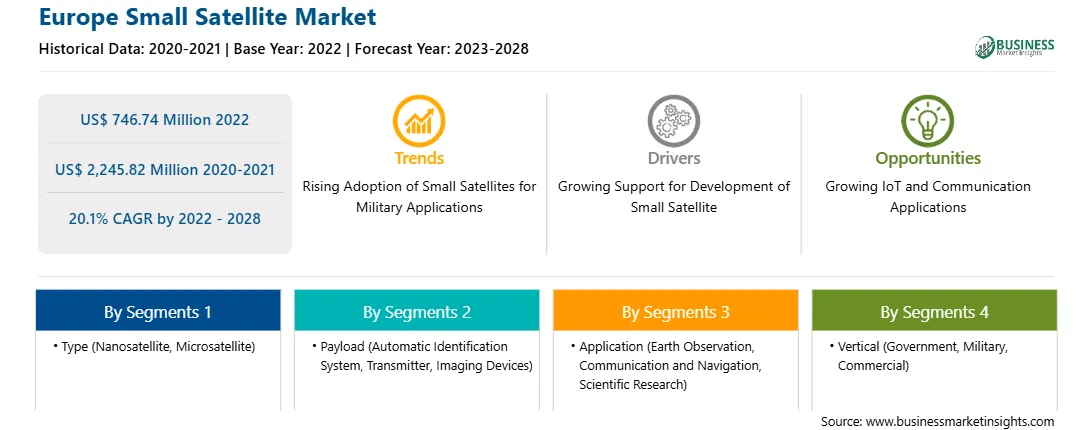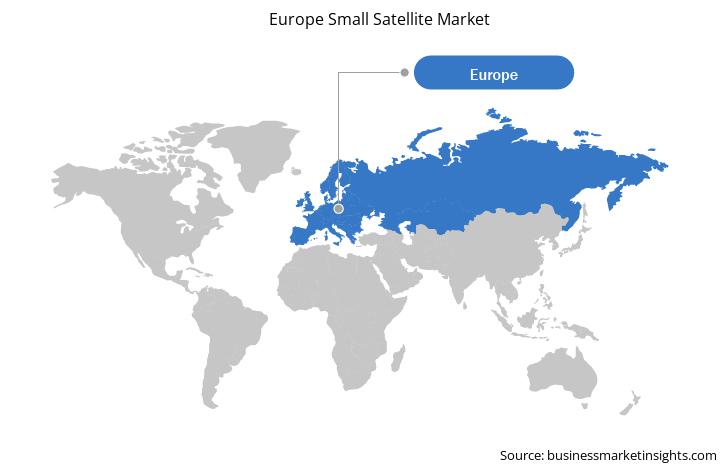Increasing IoT and Communication Applications is Driving the Europe Small Satellite Market
Internet access, machine-to-machine communication (M2M), and the Internet of Things (IoT) are among the most important applications of a small satellite. Space has become an ideal solution to improve the efficiency of current terrestrial communication networks. According to Alén Space, by 2025, more than 25.2 billion IoT connections are predicted to exist in the region, and the IoT market will reach US$ 1,072.08 billion (€ 950 billion). Also, small satellite constellations can play an important role in various environmental conditions, especially in remote or hard-to-reach places, where real-time data is received from all types of sensors and linked devices for IoT-based business models. Thus, a small satellite helps receive, store, and transmit real-time information to any point. The small satellite can also be effective for remote management. Sensors can help to control all devices, receive real-time information, and send commands for configurations remotely across the Europe. Satellite communications support land-based communications in Amazon basin, Antarctica, offshore platforms, critical infrastructure like nuclear power plants, and other hard-to-reach areas. Also, small satellites guarantee communication in any circumstances in virtually uncommunicated areas such as large rural areas, desert territories, frozen areas, jungle areas, and high seas. For high internet access, several projects are being launched in various developed and developing regions where small satellites play a major role. The growing internet access in Europe will propel the demand for small satellites during the forecast period. Thus, the rising demand for small satellites to provide internet access, M2M communication, and IoT will create a lucrative opportunity for market growth in the forecasted period.
Europe Small Satellite Market Overview
Based on country, the small satellite market in Europe is segmented into Germany, France, Italy, the UK, Russia, and the Rest of Europe. Over the years, satellite research & development programs and production facilities have increased in Europe. The region is also highly dependent on space services for applications such as earth observation, and communication and navigation. According to European Parliamentary Research Service (EPRS), 10% of Europe’s GDP is supported by satellite navigation signals. For instance, according to EPRS, in 2021, the global navigation satellite systems (GNSS) recorded a total revenue of US$ 174.27 billion, in which Europe accounted for 25% of the total revenue. Thus, the growing demand for nano and micro satellites for communication and navigation applications across the country is constantly increasing across the region.
Europe Small Satellite Market Revenue and Forecast to 2028 (US$ Million)
Strategic insights for the Europe Small Satellite provides data-driven analysis of the industry landscape, including current trends, key players, and regional nuances. These insights offer actionable recommendations, enabling readers to differentiate themselves from competitors by identifying untapped segments or developing unique value propositions. Leveraging data analytics, these insights help industry players anticipate the market shifts, whether investors, manufacturers, or other stakeholders. A future-oriented perspective is essential, helping stakeholders anticipate market shifts and position themselves for long-term success in this dynamic region. Ultimately, effective strategic insights empower readers to make informed decisions that drive profitability and achieve their business objectives within the market.

| Report Attribute | Details |
|---|---|
| Market size in 2022 | US$ 746.74 Million |
| Market Size by 2028 | US$ 2,245.82 Million |
| Global CAGR (2022 - 2028) | 20.1% |
| Historical Data | 2020-2021 |
| Forecast period | 2023-2028 |
| Segments Covered |
By Type
|
| Regions and Countries Covered | Europe
|
| Market leaders and key company profiles |
The geographic scope of the Europe Small Satellite refers to the specific areas in which a business operates and competes. Understanding local distinctions, such as diverse consumer preferences (e.g., demand for specific plug types or battery backup durations), varying economic conditions, and regulatory environments, is crucial for tailoring strategies to specific markets. Businesses can expand their reach by identifying underserved areas or adapting their offerings to meet local demands. A clear market focus allows for more effective resource allocation, targeted marketing campaigns, and better positioning against local competitors, ultimately driving growth in those targeted areas.

Europe Small Satellite Market Segmentation
The Europe small satellite market is segmented based on type, payload, application, vertical, and country.
Based on type, the Europe small satellite market is bifurcated into nanosatellite (1 to 10 Kg) and microsatellite (10 to 150 Kg). The microsatellite (10 to 150 Kg) segment held a larger market share in 2022.
Based on payload, the Europe small satellite market is segmented into automatic identification system (AIS), transmitter, imaging devices, and others. The automatic identification system (AIS) segment held the largest market share in 2022.
Based on application, the Europe small satellite market is segmented into earth observation, communication and navigation, and scientific research. The earth observation segment held the largest market share in 2022.
Based on vertical, the Europe small satellite market is segmented into government, military, and commercial. The commercial segment held the largest market share in 2022.
Based on country, the Europe small satellite market is segmented into Germany, the UK, France, Italy, Russia, and the Rest of Europe. France dominated the market share in 2022.
Dauria Aerospace; GomSpace Group AB; Lockheed Martin Corp; Northrop Grumman Corp; Raytheon Technologies Corp; Sierra Nevada Corp; Surrey Satellite Technology Ltd; Thales SA; and Tyvak international SRL are the leading companies operating in the Europe small satellite market.
The Europe Small Satellite Market is valued at US$ 746.74 Million in 2022, it is projected to reach US$ 2,245.82 Million by 2028.
As per our report Europe Small Satellite Market, the market size is valued at US$ 746.74 Million in 2022, projecting it to reach US$ 2,245.82 Million by 2028. This translates to a CAGR of approximately 20.1% during the forecast period.
The Europe Small Satellite Market report typically cover these key segments-
The historic period, base year, and forecast period can vary slightly depending on the specific market research report. However, for the Europe Small Satellite Market report:
The Europe Small Satellite Market is populated by several key players, each contributing to its growth and innovation. Some of the major players include:
The Europe Small Satellite Market report is valuable for diverse stakeholders, including:
Essentially, anyone involved in or considering involvement in the Europe Small Satellite Market value chain can benefit from the information contained in a comprehensive market report.